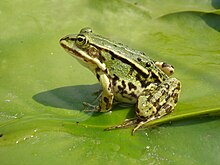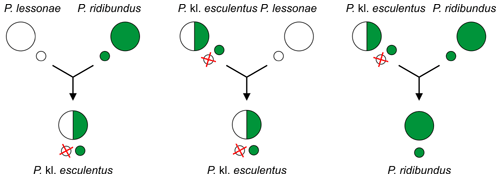Edible frog
| Edible frog | |
|---|---|

| |
| Scientific classification | |
| Domain: | Eukaryota |
| Kingdom: | Animalia |
| Phylum: | Chordata |
| Class: | Amphibia |
| Order: | Anura |
| Family: | Ranidae |
| Genus: | Pelophylax |
| Species: | P. ridibundus |
| Binomial name | |
| Pelophylax kl. esculentus | |
| Synonyms | |

The edible frog (Pelophylax
It is used for food, particularly in France for the delicacy frog legs. Females are between 5 and 9 cm (2.0 and 3.5 in) long, males between 6 and 11 cm (2.4 and 4.3 in).
This widespread and common frog has many common names, including European dark-spotted frog, European black-spotted pond frog, and European black-spotted frog.
Distribution
Pelophylax esculentus is endemic to Europe. It naturally occurs from the northern half of France to western Russia, and from Estonia and Denmark to Bulgaria and northern Italy. The edible frog is introduced in Spain,[3] Norway[4] and the United Kingdom.[5] The natural range is nearly identical to that of P. lessonae.[6]
Hybridogenesis
Pelophylax kl. esculentus is the fertile
Hybridogenesis implies that during gametogenesis hybrids (of RL genotype) exclude one parental genome (L or R) and produce gametes with an unrecombined genome of the other parental species (R or L, respectively), instead of containing mixed recombined parental genomes.[8][9][11] The hybrid populations are usually propagated by mating (backcrosses) with a sympatric parental species – P. lessonae (LL) or P. ridibundus (RR) – providing the second, discarded parental genome (L or R respectively).[8][9][11] Hybridogenesis is thus a hemiclonal mode of reproduction; half of the genome is transmitted to the next generation clonally, unrecombined (intact); the other half sexually, recombined.[12][10][11]
For example, in the most widespread so called L–E system, edible frogs Pelophylax kl. esculentus (RE) produce gametes of the marsh frog P. ridibundus (R) and mate with coexisting pool frogs Pelophylax lessonae (L gametes) – see below in the middle.[8][11]

Because this hybrid requires another taxon as a sexual host to reproduce, usually one of the parental species, it is a klepton[13][14][15]. Hence the addition of the "kl." (for klepton) in the species name.[16]
There are also known all-hybrid populations, where diploid hybrids (LR) coexist with triploid (LLR or LRR) hybrids, providing L or R genomes respectively. In this situation, diploid hybrids (LR) generate not only haploid R or L gametes, but also the diploid gametes (RL) needed to recreate triploids.[8][9]
-
Swimming frog
-
Attempted copulation between two males
-
Example of cannibalism
-
Close-up of head
-
Head close-up, another perspective
-
Edible frog on a human arm
-
Edible frog in pond habitat
-
Edible frog in a swamp
References
- ^ Frost, Darrel R. (2006). "Amphibian Species of the World: an Online Reference. Version 4". American Museum of Natural History, New York, USA. Retrieved 17 August 2006.
- ^ Frost, Grant, Faivovich, Bain, Haas, Haddad, de Sá, Channing, Wilkinson, Donnellan, Raxworthy, Campbell, Blotto, Moler, Drewes, Nussbaum, Lynch, Green, and Wheeler 2006. The amphibian tree of life. Bulletin of the American Museum of Natural History. Number 297. New York. Issued March 15, 2006.
- doi:10.2305/IUCN.UK.2009.RLTS.T58705A11825745.en. Retrieved 6 November 2023.)
{{cite journal}}: CS1 maint: multiple names: authors list (link - ^ "Pelophylax esculentus". artsdatabanken.no (in Norwegian). Retrieved 2022-05-10.
- ^ "Non-native amphibians". The Amphibian and Reptile Conservation Trust. Archived from the original on 9 September 2017. Retrieved 9 September 2017.
- ^ "Pelophylax esculentus, Edible Frog". AmphibiaWeb. Retrieved 28 January 2014.
- ^ Berger, L. (1970). "Some characteristics of the crossess within Rana esculenta complex in postlarval development". Ann. Zool. 27: 374–416.
- ^ S2CID 23535815. Archived from the original(PDF) on 2019-07-13. Retrieved 2015-06-21.
- ^ PMID 19527499.
- ^ S2CID 20453910. Retrieved 2015-06-21.
- ^ PMID 17517158. Retrieved 2012-07-25.
- . Retrieved 2012-07-30.
- ISBN 978-0-19-536967-0.
- ISSN 0044-5193.
- ^ Polls Pelaz, Manuel (October 1990). "The Biological Klepton Concept (BKC)". Alytes. 8 (3). ISSCA (International Society for the Study and Conservation of Amphibians): 75–89. Archived from the original on 2014-07-14. Retrieved 2015-06-22.
- ^ Dubois, Alain (October 1990). "Nomenclature of parthenogenetic, gynogenetic and hybridogenetic vertebrate taxons: new proposals". Alytes. 8 (3). ISSCA (International Society for the Study and Conservation of Amphibians): 61–74. Archived from the original on 2015-06-23. Retrieved 2015-06-22.
External links
- ArchéoZooThèque : Edible frog skeleton drawing Archived 2019-09-13 at the Wayback Machine
- Species account on HerpFrance.com Archived 2015-09-24 at the Wayback Machine
- Video: Pool frogs and hybrid green frogs on YouTube. Mixed mating of pool frog and edible frog; pool frog are grass green and smaller.









